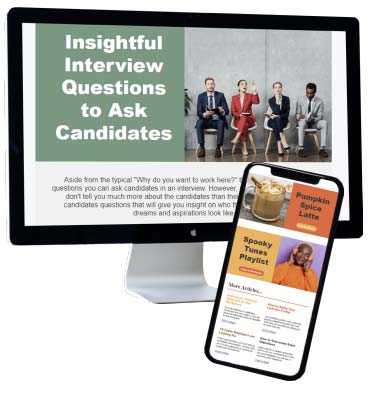Before You Go!
Sign up for our newsletter - which features professional templates, job market updates, articles, playlists, recipes, and more, sent directly to your inbox!



By: JoAnne Williams, CEO
Dramatic changes have occurred in our industry recently, and the stakes are higher than ever. Staying in the game with less than the best players on your team doesn't make sense. As radical as it may sound, evaluating your current team in terms of who you will support and who you may need to eliminate is one of the keys to success in today's market.
After going through the evaluation process, you may need to make hiring decisions based on your assessment of gaps in talent and skills. If you are "filling in" skills and talent around your existing employees, be certain they deserve to continue with the team as your company recovers, expands, and realizes the ownership's vision for the next decade.

A critical analysis in assessing each of your employees (not limited to the executive team) should include examining the characteristics and attributes important to you and your company's success. Look at the players you just can't live without. These are the employees that best-selling business author Seth Godin refers to as "linchpins" in his book, Linchpin: Are you Indispensable?
Without allowing yourself to compromise, ask yourself if your current staff members possess the following:
If any of your employees fall short of your expectations, you may have a team member who will not fit into the long-term strategy of your company. Or you may have a great opportunity to re-evaluate either you or your management team's style in providing a healthy team environment. Are these employees capable of improvement with proper coaching and accountability? Is your corporate culture one that supports, encourages, and coaches members to perform to the best of their ability?
Jim Collins’ book “Great By Choice” is based on a study (unlike his previous books based on employee performance or stature) that considered employee performance based on the extremity of the environment. Isn’t that what is needed now during these times of uncertainty and shifting strategies? Navigating in rough economic waters provides managers the perfect opportunity to see who they need to help them lead (and perhaps take on multiple roles) and whose thinking is limited to self-survival.
When all is said and done, hiring the right person is only part of the equation. The organization and management has to cultivate an environment in which all members of the team thrive and grow together through collaboration and trust.
First of all, an employee should not find it surprising that he/she is being fired. It is standard practice to give employees verbal and written warnings with guidelines for performance improvement. An accountability plan that has been implemented for 30 to 60 days with realistic goals is fair and provides them with the opportunity to get back on track with your assistance. If they fail to improve, you should let them go.
You pick the day and time. I would not suggest a Friday. Monday might be a better and fairer option because the next step for them will be to find another job. A Monday lays out the week ahead of them to begin their search and focus forward.
Have the discussion in a private place like a conference room with another team member present as a witness, preferably a representative from the HR department or a supervisor (never a peer of the employee being let go). Be brief and be clear – there is no room for discussion regarding the decision.
Have a check-list prepared to be certain you obtain passwords, keys, company laptops, cell phones and other equipment.
You can let the person go home immediately and make another appointment with a company representative to collect their things, or you (or the representative) can escort them to their office or desk to collect their personal things and help them to their car.
I would also recommend seeking counsel with your labor law attorney or human resources consultant.

It is extremely important to find team members who possess the same wonderful attributes we just evaluated, not to mention you owe it to your existing staff to provide like-minded colleagues. While there is no magical secret that gets you the right candidate 100% of the time, after many years of helping companies find the perfect fit for their open positions, I have discovered the essential things you must do in your hiring process.
When you clarify a role’s expectations upfront, it’s easier for you and the job seeker to determine if they’re the right fit for the position. Before you start interviewing candidates (or even posting the job ad), it’s essential to get a clear grasp of the type of person you would like to hire for the job. Defining your ideal candidate goes beyond identifying the hard skills you require; your list should also include soft skills that would help a professional excel in the given position. Hard skills are teachable abilities such as writing, math, computer skills, and so on. Soft skills, on the other hand, are personal attributes such as communication, work ethic, or teachability. Make sure the list includes every expectation you have for your future employee and describes each expectation in as much detail as possible. Then, use this list to create a well defined job description and reference checklist during the interview process.
To map out your hiring strategy, you’ll need to determine your time frame, budget, & where you will source candidates. This will ensure that all team members are on the same page when it comes to identifying a candidate.
Time Frame
From writing a job description, reading through applications, and scheduling phone screens/interviews, to administering assessments, conducting multiple rounds of interviews, and processing background checks, hiring is, and should be, a be a time-consuming process. Set clear guidelines for everyone on the team so that the expectation for the date of hire is realistic. Also, keep in mind that strong candidates likely have several interviews and offers on the table. Be sure to keep your process moving quickly enough that you can make your potential new superstar an offer before another company does.
Budget
With job board fees, background checks, and employee labor costs, hiring can get expensive. According to a study done by the Society for Human Resource Management, it can cost up to 50-60% of an employee’s annual salary to find a direct placement. Of course, that statistic varies significantly based on your employee’s salary, but the point here is that a LOT of money goes into finding the right candidate.
Let’s break it down. To reach the most candidates, you’ll want to post your job ad on multiple job boards. Job boards don’t just have varying costs, they also have different pricing models:
With all of these variations, posting one job ad on a single platform can cost you anywhere from $60-500+ a month. Then, factor in the price of conducting background checks, which can be anywhere from $50 to $75 per check. Last, consider the labor cost of your employees who are sourcing, screening, onboarding, and training candidates. Put all three of these figures (job boards + background checks + labor costs) together & you have a ballpark figure of what hiring your new candidate will cost.
Where to Source
In addition to mapping out your time frame and budget, you’ll also need to establish where you intend to find the right candidate for the job (hint: this also factors into your budget). Will you post your job on social media, Indeed, ZipRecruiter, Monster, or some other online platform? Are you planning on participating in a job fair? Might you enlist a staffing agency in your search (more on this below)? Will you need to access candidate databases (i.e., the ability to contact passive candidates) like LinkedIn’s? Each recruitment platform offers a different candidate pool, so do your research to determine which source(s) might work best for you.
Using a Staffing Agency
Not only does partnering with a staffing agency allow you to work with highly qualified and experienced recruiters, but it’s also a sure way to find the right fit without all of the stress of hiring yourself. Most quality staffing agencies will have some type of satisfaction guarantee. For example, JWilliams Staffing has a 60-day replacement guarantee, meaning there’s no risk for you if the employee doesn’t work out.
Whether a staffing agency fits into the beginning of your search strategy or if you’d like help only after your recruiters have been searching for X amount of days, a staffing agency can be a huge help. Keep in mind that while many search firms require a retainer, or charge you regardless of their results, some do not. JWilliams Staffing operates as a contingency firm. A contingency firm only charges you a fee if you hire one of the candidates sent to you by the agency. For example, if you interview a few candidates sent to you by a contingency firm, but end up hiring a candidate you found by your own means (a referral, internally, via your listing, etc.), you won’t pay the firm a dime.

Creative interviews can increase your likelihood of finding the right candidate. Stay away from the interview “status quo” by changing up the environment. Unique scenarios will help you get a better idea of how a candidate behaves and communicates on a day to day basis. The following are a few ways you can interview creatively.
Engage in Small Talk
Adding a little bit of light conversation before and during an interview helps put the job seeker at ease, allowing them to speak more freely, revealing their true character and intentions. Just keep in mind, there are some topics you should avoid. For example, questions or conversations regarding the applicant’s age, disability, or marital status before hire are all illegal. If you’re interested in a more in-depth review of what you CANNOT ask in an interview, this article is a helpful resource: Questions Not to Ask in an Interview.
Involve Internal Staff
If you have internal staff who will be working in the same department as the person you will be hiring, include them in the interview. Including these team members will give you a better idea about how your prospective new hire will interact on the job & also allows you to get some secondary opinions.
Get Away From Your Desk
Interview in a different location and use this as an opportunity to see how the candidate behaves. For example, rather than holding the entire interview sitting in your office or conference room, give the candidate a tour of the whole office. You can get a really good sense of whether you want to be working with somebody when you walk them through the workplace. Pay attention to how they interact – do they ask questions about how things work? Do they treat everyone with respect and show interest? Use this opportunity to see if they have the right attitude to join your team.

Interviewing has become so calculated that candidates are coming into interviews with answers prepared for almost every question. This fact begs the question…if candidates are coming in equipped with strong answers, instead of authentically answering on the spot, how will you know if they are the right match? A great way to get around receiving a candidate’s pre-formulated answers is to think outside of the box and ask questions that give you insight on their behavior and personality in the workplace.
First, look for questions that provoke answers that demonstrate what you need to know:
Next, make sure your questions are unique enough that the candidate won’t be expecting them (keeping in mind, you’re not trying to trip up or trick the candidate, you are merely avoiding questions they may have a pre-formulated answer to). Ask the candidate questions like, “Think about a time when you felt your boss was not making the right decision. How did you deal with the situation?” Questions like this will help you determine how the candidate deals with stressful situations. Or you can ask them a question where a specific skill comes into play such as, “Tell me about a time you felt like you were putting out fires at work. What kinds of problems were people throwing at you? Give me examples of the solutions you developed.” If someone claims to have excellent problem-solving skills, questions like this will help you determine just how skillful they are.
You should also strive to ask questions that fall into each of these four categories: Motivational, Emotional Intelligence, Situational & Behavioral, and Knowledge Assessment. You can find more about these types of interview questions and how you can use them in our article “12 Insightful Interview Questions to Ask Candidates”.
So you like the candidate; the next step is to check references – seriously!
Ask for as many details as the reference is willing to share regarding the candidate's ability to manage, motivate, hire, and develop others:

High-quality candidates are likely to receive multiple offers and are typically off the market within ten days. This fast-paced job market is why it is so crucial that you act quickly – especially when you know you’re interested in a specific candidate. Think of it as “protecting your asset.” Candidates appreciate timely communication, so even if you haven’t made a decision yet, you should follow up frequently; however, it’s best if you can make your decision immediately.
Presenting the job offer and negotiating the compensation plan will be key to capturing the attention of your candidate. "High performing companies present their compensation proposition as a buy-in to the future growth of the business and are more capable of recruiting top-tier talent," stated Tom Miller, president of Irvine, Calif-based Vision Link Advisory Group. As an advisor to mid-size and publicly traded companies, Tom works on structuring compensation and incentive plans and says that candidates must see a meaningful future in order to produce the kind of value that will create significant financial opportunity for them.
Ready to hire your next superstar? You’ve got the tips to do it! If you find you or your team short on time or resources, a staffing agency could be the solution for you. Our team can do the leg work for you, saving you time and money while helping you hire the right candidate!
Contact our Full Service Staffing team to learn more: FullSuite@JWIlliamsStaffing.com or 949-398-0068
